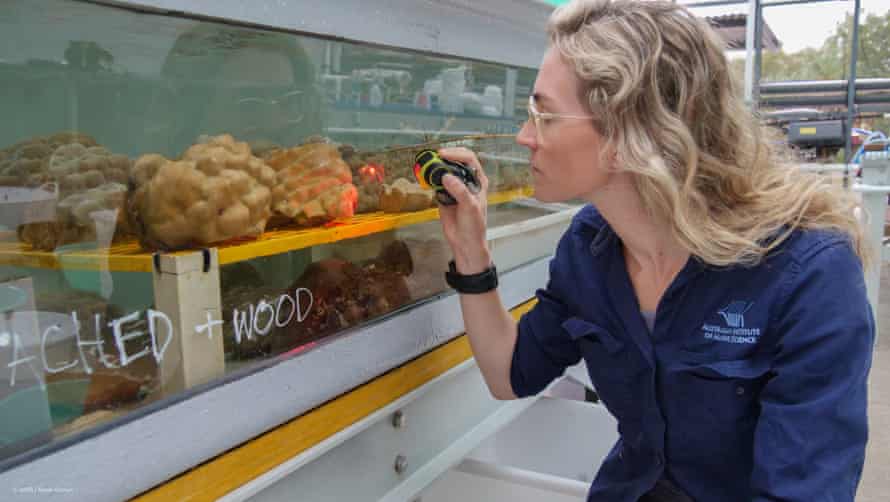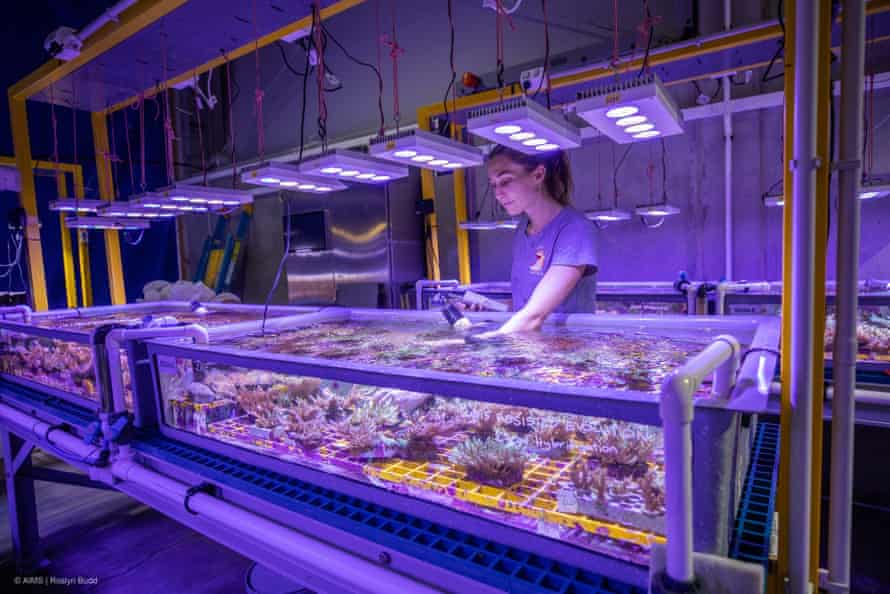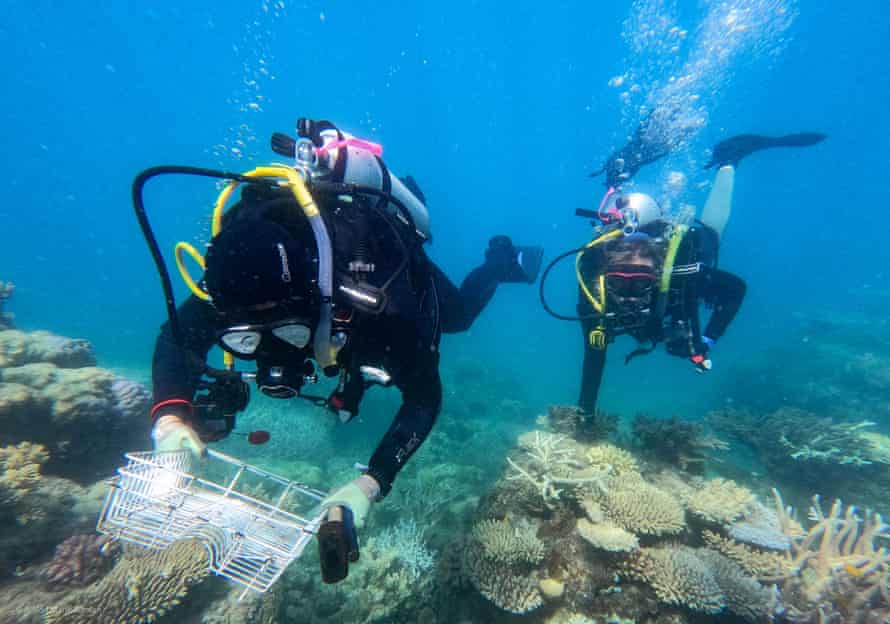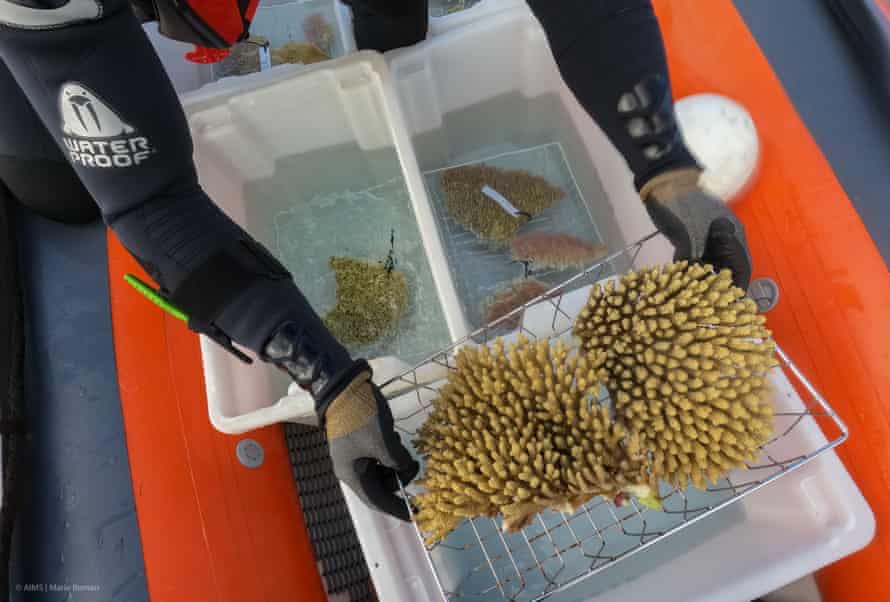Scientists have carefully collected spawn bundles by moonlight in a bid to help save the reef
It’s nearing 10pm, and Dr Kate Quigley is still waiting. Using red lights to minimise disruption to the animals’ behaviour, she is inspecting corals.
Quigley, who studies reef restoration at the Australian Institute of Marine Science, is looking for “little red dots all over the surface”. A pimply appearance is a hallmark sign that a coral is about to spawn, releasing sperm and eggs in bundles resembling small bubbles.
Depending on the species, they can be vivid pink, purple or blue. “It’s almost like shaking one of those snow globes,” Quigley says. “You see all the little particles in the water.”

Quigley is working at AIMS’s National Sea Simulator, a vast facility in Townsville where more than 3m litres of filtered seawater is pumped through daily, housing huge numbers of coral colonies. At the SeaSim, as it is known, humming tanks are calibrated at specific temperatures and partial pressures of carbon dioxide – the latter for experiments on ocean acidification.
Coral spawning, which occurs en masse once a year, is one of Earth’s great biological spectacles. Quigley likens the scale and grandeur of it to the annual mammal migrations in Africa.
Up and down the Great Barrier Reef, for several days after the November full moon (this year on 19 November), multiple species of corals synchronise the release of their sperm and eggs. Out in the ocean, billions of these bundles float to the water’s surface, fertilise and develop into larvae that eventually settle on the reef and form new coral colonies.
The corals housed at the SeaSim spawn in captivity at the same time as they do in the wild. For several consecutive days this week, Quigley and her colleagues have worked late into the night, carefully collecting spawn bundles for a selective breeding program.
Each spawning coral is kept in its own separate container, so its bundles can be isolated. Many are housed in outdoor tanks, under the moonlight, which is an important cue that triggers the spawning event. For corals kept indoors, the SeaSim has finely calibrated facilities that allow scientists to replicate both the timing and intensity of both sunlight and moonlight.

“We’re now able … to replicate those natural signals that the corals would need,” Quigley says. She and her team collected hundreds of the spawning corals only in the last fortnight. Leaving the marine invertebrates in their natural environments for as long as possible also maximises their exposure to cues for spawning they would get in the wild, which includes a rapid rise in temperature around this time of year.
Breeding for heat resilience
The Great Barrier Reef comprises more than 3,000 individual reefs, a patchwork of marine life roughly the size of Italy. There is a natural temperature gradient from north to south: the waters in the northern part of the reef, closer to the equator, are warmer.
“Those corals up [north] are better able – just through the exposure that they’ve had over their lifetime – at withstanding high temperatures,” Quigley says. “In the southern Great Barrier Reef, it’s colder down there, so when [corals] get hit by a heatwave, they’re much more vulnerable.”
Natural differences in heat tolerance forms the basis of Quigley’s selective breeding research. Late last year, she developed a machine learning algorithm that produces GPS coordinates indicating where the most heat-resilient corals might be.
Last week, she and her team returned from an expedition to the far northern Great Barrier Reef, 875km away from the SeaSim. Using her algorithm, they collected hundreds of potentially heat-resilient corals, which had survived the high temperatures of the 2016, 2017 and 2020 mass bleaching events.


After the spawning in the SeaSim, the scientists will breed the heat-hardier corals with more vulnerable specimens collected from the southern Great Barrier Reef. The process of mixing spawn is “not dissimilar to mixing cocktails in specific proportions”, Quigley says. “We can control who the mum is and who the dad is … we’re able to create baby corals that have a mixture of these genetics.”
The research speeds up a natural process called gene flow. Research shows that corals’ genetic material, including heat-adaptive genes, spreads naturally across the reef. “There is movement of genes,” Quigley says. “However, it’s probably going to happen too slow for the kind of rate of warming that we’re getting now.”
Accelerating the spread of genetic material is one of several techniques being explored to help make the reef more resilient, says Dr Line Bay, who leads the reef recovery, adaptation and restoration team at AIMS.
Corals live in symbiosis with microscopic algae, which play an important role in their growth and survival. “We have several projects that are looking at how those algae affect the health of corals and whether we can influence … the heat tolerance of corals through direct selection of the algae,” Bay says.
Climate change ‘a very significant threat’
In the SeaSim, tank temperatures can be dialled up to test how well corals – either those that are selectively bred, or that have heat-tolerant algae – might withstand the heat of bleaching events.
The Intergovernmental Panel on Climate Change report projects that under 2C of global warming, 99% of coral reefs will decline. “As we move into the future, we know that the water is going to warm, not only much, much hotter, but also much faster,” Quigley says.
For the first time this year, the team is hoping to selectively breed a species of Porites coral – massive, slow-growing corals that resemble boulders. If successful, it will be the sixth species included in the program.

The Great Barrier Reef contains around 400 different species of coral, estimates Prof Terry Hughes, an internationally renowned coral reef scientist at James Cook University.
The AIMS research sheds light on the characteristics of wild corals following recent bleaching events, Hughes says. “It tells us about their heat tolerance, it tells us whether that heat tolerance is shifting.
“We also get badly needed information on how the Barrier Reef is wired in terms of movement of larvae from one place to another – gene flow.”
Hughes, who directs the ARC Centre of Excellence for Coral Reef Studies, says a hurdle for coral restoration projects is the huge scales they must work on to have an impact.
“If you wanted to improve coral cover [on the Great Barrier Reef] … by 1%, you’d need 250m large corals,” he says. That would involve rearing fast-growing coral species for around five years to get them to the size of a dinner plate. “As a pathway towards intervention, scale will always be the biggest challenge.”
Bay emphasises that reef restoration “is no silver bullet. Climate change is a very significant threat to coral reefs and we need strong action on climate change to give ourselves the best chance of survival into the future,” she says.
Quigley agrees. “When you think about the scale of the ecosystems that are being impacted, like the Amazon, like the Great Barrier Reef – these are huge, complex ecosystems that people have been studying for a long time, but we’re just scratching the surface in terms of understanding fundamentally how they operate.”
The number one priority for saving the reef is to curb carbon emissions, Quigley says. Management practices, such as regulation of water quality, programs to remove crown-of-thorns starfish, and managing fisheries, will also help to alleviate pressure on the ecosystem.
“And then third, we can look at these innovative restoration concepts,” she says. “We can start to think … what kind of restoration can we develop now, while there’s still time.”